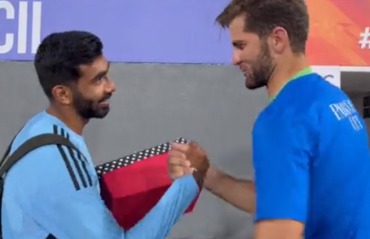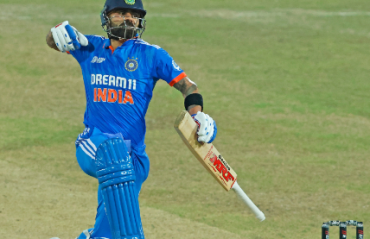#TFGtake: Why Shastri & co. is a malady that needs to be cured for Indian cricket's good
10 overs, 106 runs, 1 wicket.
7 overs, 84 runs, 1 wicket.
WHEN THE ONLY TWO pace bowlers in your team are handed a pounding so hard and so forgettable in a deciding game, as a captain you have no choice but to say "it has happened in cricket, it keeps happening.” MS Dhoni's post-match conference after a devastating series defeat to South Africa was a clear indicator of the fact that India are still struggling to produce genuine, wicket-taking fast bowlers.
India's 214-run loss on Sunday was their second biggest defeat in ODIs in terms of runs. On what was a batting paradise at Wankhede, the South African batsmen took full advantage of a listless bowling attack, nailing the series 3-2. Let's give some credit to the three centurions -- Quinton de Kock, AB de Villiers and Faf du Plessis -- who dominated the Indian bowlers from start to finish. Unfortunately, there was a fourth centurion, but from the Indian camp -- Bhuvneshwar Kumar. Zaheer Khan, who was present at the Wankhede on Sunday, would have been distraught.
This mind-numbing loss has once again exposed the long-standing issue in the Indian cricket team -- the fast bowling attack. Not only did Bhuvneshwar Kumar and Mohit Sharma fail to 'strike' at regular intervals, but they also gave away too many runs
due to their inability to contain the South African batsmen on a placid pitch. There was no bounce, no turn, and well, no skill.
It is a known fact that India is a spin-friendly nation, and a turning wicket is their strength. But how often has this team won a match because of skilled fast bowlers who have destroyed batsmen on the flattest of decks? Prior to the final ODI, former South African captain Shaun Pollock said he was surprised that India fails to produce genuine quicks, as compared to their neighbours, Pakistan.
"It is a funny one to understand as to why it happens that Pakistan produces so many fast bowlers and India can't especially when the border is so close between both countries. It is weird to understand why India struggles to get those kinds of bowlers coming through consistently. I don't know if it is just because of the genes or the things that they eat growing up. The difficulty for the people in India is the amount of cricket you play," Pollock told bcci.tv in an interview.
While this may be one side of the story, Dhoni's post-match explanation sums up the harsh truth about fast bowling in India. Apart from the fact that there are many bowlers who claim to be 'quick', a lot of them are actually wayward and leak runs aplenty. As a result, India have opted for bowlers who can maintain their line and length instead. Perhaps, it is this mentality that has forced some of the aspiring fast bowlers in India (Varun Aaron, Umesh Yadav, Ishant Sharma) to sacrifice their
one true asset -- pace.
Why would bowlers settle for line and length, when all they dream of is running in and bowling quick? It is a result of mental conditioning. Indian bowlers are told to be economical from the get-go, instead of allowing them to give runs at the cost of taking wickets. On the other hand, grooming potential fast bowlers isn't the easiest thing to do. It requires patience, time and faith; and there's the need for a lot of investment in time and effort required from the team, its management, and the captain.
But, instead of finding and implementing long-term solutions, which requires effort, we have Ravi Shastri, the supremo of the team, who thinks the problem can be solved if friendly wickets help the team hide their weaknesses. Never would Shastri have thought that his team would get such a pounding. In fact, if India had batted first, scored 438, and South Africa had chased down the total losing just 2-3 wickets, still there would have been no worries on the bowling.
When the opponent put up such a mammoth score, it was difficult to ignore the fact that the bad bowling had something to do with the free flow of runs. Instead of addressing the elephant in the room, Shastri prefers to find a scapegoat, sending the worst signal possible -- don't you players worry, we will use expletives and fire everyone who was responsible for the thrashing you got till they accept their fault and adhere to our wishes.
It is this attitude that needs immediate change. When the Team Director thinks the pitch-maker is the culprit and has the gumption to taunt him, where is the motivation for the existing players to improve, or for the selectors to find or create good replacements and nurture them. In this case, the curator of the pitch was a former India opener, Sudhir Naik, who could stand up to Shastri. Imagine the plight of lesser mortals who will now be quacking in their boots while waiting for exact orders from headquarters on pitch-making. And they won't have to worry only about Shastri. According to a report in The Times of India, the bowling coach, Bharat Arun, also had a few things to say to Naik's assistant Ramesh Mahamulkar.
What this also does is divert attention away from the mistakes of the batsmen who made a hash of the chase. On paper, India has a stronger batting arsenal, and though it was a huge score, it didn't look like there was any thought given to how the team should go about it -- you need to only look at Virat's way of gifting his wicket to understand this. And why would the Team Director need to have a strategy when he has already decided whom to blame.
It would do good for the future if BCCI's mandarins see this thumping as a blessing in disguise, which has shown the bowling, and the famed batting, in true light. If we allow the likes of Shastri to expletive away a loss on an unfriendly pitch, even Pollock will not only stop wondering why we don't produce genuine quicks, but also question our ability to bat on flat tracks.
TFG NEWSLETTER: Exclusive and Stimulating articles delivered Free into your Inbox every day! Subscribe to TFG TIMEs





























